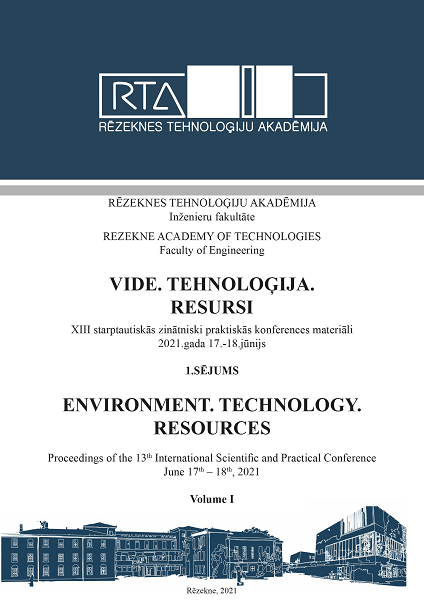EVALUATION OF VIBRATION-BASED GLOBAL STRUCTURAL HEALTH MONITORING METHOD FOR MEDIUM-RISE BUILDINGS
DOI:
https://doi.org/10.17770/etr2021vol1.6598Keywords:
Medium-rise building, Structural Health Monitoring, Vibration-based methodAbstract
The automated monitoring of a building’s structural health during its exploitation is a way to extend its design life without compromising structural safety. In turn, it helps increase the rate of building renovation works compared to demolition works, which reduces future construction and demolition waste levels.
This research explores the vibration-based global monitoring method application to structurally stiff medium-rise reinforced concrete buildings by analysing predicted building vibration amplitudes and spectrum under regular city traffic excitation. These predictions are based on the results obtained from finite element calculations of building models with variated structural stiffness and inertial mass of the building.
Regular traffic-generated ground frequency spectrum differs from the first natural frequencies of medium-rise reinforced concrete buildings, and the vibration energy is low. Nevertheless, it is found that the structural identification of such building dynamic parameters is still possible, particularly natural frequencies. It was found that the ratio between fundamental frequency for the fixed base model of the building and elastic spring foundation model is the decisive parameter for selecting the building part to be monitored. Structural health monitoring vibration-based methods are also a promising technology for medium-rise mass house buildings when tailored according to some damage sensitive feature.
Downloads
References
D. F. Laefer and J. P. Manke, “Building Reuse Assessment for Sustainable Urban Reconstruction,” J. Constr. Eng. Manag., 2008.
“EN 1990. Eurocode-Basis of structural design.” .
C. R. Farrar and K. Worden, Structural Health Monitoring: A Machine Learning Perspective. 2012.
D. M. Frangopol and T. B. Messervey, “Maintenance Principles for Civil Structures,” in Encyclopedia of Structural Health Monitoring, John Wiley & Sons, Ltd, 2009.
D. M. Frangopol, “Life-Cycle performance, management, and optimisation of structural systems under uncertainty: Accomplishments and challenges,” Struct. Infrastruct. Eng., 2011.
H. N. Li, L. Ren, Z. G. Jia, T. H. Yi, and D. S. Li, “State-of-the-art in structural health monitoring of large and complex civil infrastructures,” J. Civ. Struct. Heal. Monit., 2016.
V. M. Karbhari and F. Ansari, Structural health monitoring of civil infrastructure systems. 2009.
O. Kulhanek, “Anatomy of seismograms,” Anat. Seism., 1990.
M. R. Gallipoli et al., “Empirical estimates of dynamic parameters on a large set of European buildings,” Bull. Earthq. Eng., 2010.
R. K. Goel and A. K. Chopra, “Period formulas for moment-resisting frame buildings,” J. Struct. Eng., 1997.
C. S. Oliveira and M. Navarro, “Fundamental periods of vibration of RC buildings in Portugal from in-situ experimental and numerical techniques,” Bull. Earthq. Eng., 2010.
NEHRP Consultants Joint Venture, Soil-Structure Interaction for Building Structures. 2012.
Gaile L; Sliseris J; Ratnika L, “Towards SHM of medium-rise buildings in non-seismic areas.” Proceedings of 10th International Conference on Structural Health Monitoring of Intelligent Infrastructure - SHMII 10 (submitted), 2021.
H. Hao, T. C. Ang, and J. Shen, “Building vibration to traffic-induced ground motion,” Build. Environ., 2001.
C. Manu, “Dynamic analysis of structures with closely spaced modes using the response spectrum method,” Comput. Struct., 1986.
Y. Tamura, L. Zhang, A. Yoshida, S. Nakata, and T. Itoh, “Ambient Vibration Tests and Modal Identification of Structures by FDD and 2DOF-RD Technique,” SEWC, Yokohama, Japan, 2002.
S. Kechidi and N. Bourahla, “Effective use of ambient vibration measurement for modal updating,” in Les Premières Rencontres Nationales sur le Génie Civil RNGC’2014, 2014.
C. E. Ventura, J.-F. Lord, and R. D. Simpson, “Effective Use of Ambient Vibration Measurements for Modal Updating of a 48 Storey Building in Vancouver, Canada,” Int. Conf. “Structural Dyn. Model. Anal. Correl. Valid., 2002.
L. F. Ramos, “Damage identification on masonry structures based on vibration signatures,” 2007.
C. Michel, P. Guéguen, S. El Arem, J. Mazars, and P. Kotronis, “Full-scale dynamic response of an RC building under weak seismic motions using earthquake recordings, ambient vibrations and modelling,” Earthq. Eng. Struct. Dyn., 2010.
F. Butt and P. Omenzetter, “Long term seismic response monitoring and finite element modeling of a concrete building considering soil flexibility and non-structural components,” in Sensors and Smart Structures Technologies for Civil, Mechanical, and Aerospace Systems 2011, 2011.
D. Gargaro, C. Rainieri, and G. Fabbrocino, “Structural and seismic monitoring of the ‘cardarelli’ Hospital in Campobasso,” in Procedia Engineering, 2017.
A. F. Kamarudin et al., “Structural health monitoring on medium rise reinforced concrete building using ambient vibration method,” in IOP Conference Series: Earth and Environmental Science, 2018.
A. Nguyen, K. A. T. L. Kodikara, T. H. T. Chan, and D. P. Thambiratnam, “Toward effective structural identification of medium-rise building structures,” J. Civ. Struct. Heal. Monit., 2018.
N. J. Savnik, E. I. Katsanos, S. D. R. Amador, C. E. Ventura, and R. Brincker, “Influence of diaphragm modelling on the dynamic performance of a reinforced concrete high-rise building,” in Proceedings of ISMA 2018 - International Conference on Noise and Vibration Engineering and USD 2018 - International Conference on Uncertainty in Structural Dynamics, 2018.
M. H. Cheng and T. H. Heaton, “Simulating building motions using ratios of the building’s natural frequencies and a timoshenko beam model,” Earthq. Spectra, 2015.
V. V. Krylov, “Control of traffic-induced ground vibrations by placing heavy masses on the ground surface,” J. Low Freq. Noise Vib. Act. Control, 2007.
D. Gunn, G. Williams, H. Kessler, and S. Thorpe, “Rayleigh wave propagation assessment for transport corridors,” Proc. Inst. Civ. Eng. Transp., 2015.


